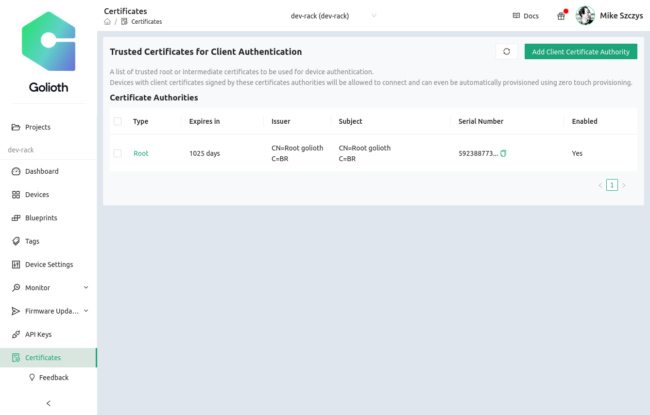Golioth Certificate-Based Authentication
Golioth is secure by default, offering a couple of different ways for your devices to establish a secure connection to the Golioth Servers. When trying out features in the lab, pre-shared keys (PSK) are fine. But when moving devices into production, there is no substitute for certificate-based authentication.
Today we are announcing the ability to use Certificates with the Golioth platform.
Certificates deliver numerous security benefits when compared to pre-shared keys. This is especially true when it comes to provisioning your IoT fleet. As devices roll off the assembly line, they can be granted individual device certificates signed using a trusted chain of root certificates and intermediate certificates. At that point, the devices are not yet registered on the Golioth server. When they first connect, the certificates are verified against the chain of trust and a record of the trust-verified device is created. This simplifies the registration of a large influx of new devices, as happens in a production environment.
Let’s walk through the process used to get to that point.
How to generate and use certificates with Golioth
Generating a self-signed root certificate
A root certificate is a cryptographic public/private key pair. The private key is used to sign all device certificates. The public key is uploaded to the Golioth server and used at the project level to verify each device certificate when establishing a secure connection.
SERVER_NAME='golioth'
# Generate an elliptic curve private key
# Run `openssl ecparam -list_curves` to list all available algorithms
# Keep this key safe! Anyone who has it can sign authentic-looking device certificates
openssl ecparam -name prime256v1 -genkey -noout -out "${SERVER_NAME}.key.pem"
# Create and self-sign a corresponding public key / certificate
openssl req -x509 -new -nodes -key "${SERVER_NAME}.key.pem" -sha256 -subj "/C=BR/CN=Root ${SERVER_NAME}" -days 1024 -out "${SERVER_NAME}.crt.pem"
The code above generates two files. The golioth.key.pem is the private key which you must safeguard. All credentials created from this private root key will be fully trusted. Golioth will not have a copy of this key.
The golioth.crt.pem is the public key that is uploaded to Golioth. This serves as a way to verify device credentials as trusted. It cannot be used to sign new device certificates, only the private key has that power.
Upload the root certificate public key to Golioth
As of December 2022, the Golioth console includes a “Certificates” option on the left sidebar menu. The resulting window is used to upload the root certificate public key. This is all that you need to do to prepare the Golioth Cloud for your fleet. As long as each IoT device has its own certificate signed with your root certificate’s private key, it will be added to this project the first time it tries to connect to Golioth.
Generate device certificates
PROJECT_SLUG='project_slug'
PRIMARY_HARDWARE_ID='primary_hardware_id'
SERVER_NAME='golioth'
CLIENT_NAME="${PROJECT_SLUG}-${PRIMARY_HARDWARE_ID}"
# Generate an elliptic curve private key
openssl ecparam -name prime256v1 -genkey -noout -out "${CLIENT_NAME}.key.pem"
# Create a certificate signing request (CSR)
# (this is what you would normally give to your CA / PKI to sign)
openssl req -new -key "${CLIENT_NAME}.key.pem" -subj "/C=BR/O=${PROJECT_SLUG}/CN=${PRIMARY_HARDWARE_ID}" -out "${CLIENT_NAME}.csr.pem"
# Sign the certificate (CSR) using the previously generated self-signed root certificate
openssl x509 -req \
-in "${CLIENT_NAME}.csr.pem" \
-CA "${SERVER_NAME}.crt.pem" \
-CAkey "${SERVER_NAME}.key.pem" \
-CAcreateserial \
-out "${CLIENT_NAME}.crt.pem" \
-days 500 -sha256
# Convert device certificates to DER format
openssl x509 -in ${CLIENT_NAME}.crt.pem -outform DER -out ${CLIENT_NAME}.crt.pem.der
openssl ec -in ${CLIENT_NAME}.key.pem -outform DER -out ${CLIENT_NAME}.key.pem.der
The root certificate is the source of trust, and all device certificates are created using this private key. This is why it is crucial that you safeguard your root certificate(s). Device credentials are created using the private key and added to your fleet during production. If newly created devices are compromised, it will not affect any other device credentials already out in the field because they don’t hold the (root) private key, they were simply generated from it.
The code above uses the Golioth Project ID as the PROJECT_SLUG and the SERVER_NAME to connect to the correct project. The root certificate public key was uploaded to this project in the previous section. When creating device certificates, the PRIMARY_HARDWARE_ID is a unique identifier that you generate (e.g. MAC address, naming scheme, any string will work). You need one of these for each device in your fleet.
As with the root certificate, the device certificate creation process will generate a public/private key pair. Both are loaded onto the device and used when establishing a secure connection to the Golioth Servers.
Golioth uses ECDSA (a note for other encryption geeks like us)
When a device is ready to connect to Golioth, it will request and download a server-side (public) certificate. That too will be signed by a trusted authority. The device will need to verify that certificate to ensure it’s not attempting to connect to a bad actor, such as someone pretending to be Golioth by using a “man-in-the-middle” (MITM) attack.
At Golioth, we are embedded developers as well as Cloud experts, so we chose an encryption that is as friendly as possible to resource-constrained devices. That is why we have all the certificates in the chain use ECDSA keys. They are significantly smaller to transfer and less resource intensive for embedded processing.
Summary
We’ve previously written about the importance of using certificates for Internet of Things (IoT) authentication. Certificate validation scales well, especially when it comes to provisioning devices during manufacture. New credentials can be signed with a root certificate without needing to share them back to the cloud server. And since those devices will be sent out into the field there’s an additional security benefit: compromised devices don’t expose symmetrical keys as is the case with PSK-based encryption.
In most cases, production deployments should consider certificate-based authentication for their IoT fleet. The certificate feature is built into Golioth and ready to use today.
We’d love to hear about how you are securing your company’s IoT fleet. Share your questions and tips on the Golioth Forum and don’t hesitate to reach out to our Developer Relations team if you’re interested in a guided tour of our certificate-based authentication!






Start the discussion at forum.golioth.io